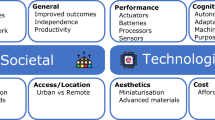Abstract
The essence of the conceptual design is getting the innovative projects or ideas to promise the products with best performance. It has been proved that the theory of inventive problem solution (TRIZ) is a systematic methodology for innovation. The design of a passively compliant robotic joint as an engineering example is illuminated in this paper to show the significance and approaches of applying TRIZ into getting the creative conceptual design ideas. In the robotic joints with passively compliance, the joints are composed of mechanical components such as springs and dampers as internal elements, which absorb the excessive collision force. Passive compliant joints with springs and dampers ensure a smooth contact with the surroundings, especially if robots are in contact with humans, but the passive compliant joints cannot determine precisely the position of the members of the joint or direction of the collision force. The main aim of this work is to show a systematic methodology for innovation as an effective procedure to enhance the capability of developing innovative passive compliant robotic joint and to overcome the main design problems. The TRIZ method will be utilized in order to eliminate the technical contradictions which appear in the passively compliant robotic joint.
Similar content being viewed by others
References
Duran-Novoa R, Leon-Rovira N, Aguayo-Tellez H, Said D (2011) Inventive problem solving based on dialectical negation, using evolutionary algorithms and TRIZ heuristics. Comput Ind 62:437–445
Cortes Robles G, Negny S, Le Lann JM (2009) Case-based reasoning and TRIZ: a coupling for innovative conception in chemical engineering. Chem Eng Process Process Intensif 48:239–249
Tong LH, Cong H, Lixiang S (2006) Automatic classification of patent documents for TRIZ users. World Patent Inf 28:6–13
Altshuller GS, Shapiro RB (1956) On psychology of inventive creativity. Probl Psychol 6:37–49
Fey V, Rivin E (2005) Innovation on demand: new product development using TRIZ. Cambridge University Press, Cambridge
Jovanović D, Petković D, Banić M (2009) TRIZ method application in development of a solar tracker. J Mech Eng Des 12(1):41–50, ISSN 1450-5401
Justel D, Vidal R, Chiner M (2006) TRIZ applied to innovate in design for disassembly. 13th CIRP International Conference on Life Cycle engineering, pp. 377–382
Stratton R, Mann D (2003) Systematic innovation and the underlying principles behind TRIZ and TOC. J Mater Process Technol 139:120–126
Kim J, Kim J, Lee Y, Lim W, Moon I (2009) Application of TRIZ creativity intensification approach to chemical process safety. J Loss Prev Process Ind 22:1039–1043
Yang CJ, Chen JL (2011) Accelerating preliminary eco-innovation design for products that integrates case-based reasoning and TRIZ method. J Clean Prod 19:998–1006
Filippi S, Motyl B, Ciappina FM (2011) Classifying TRIZ methods to speed up their adoption and the ROI for SMEs. Procedia Eng 9:172–182
Berdonosov V, Redkolis E (2011) TRIZ-fractality of computer-aided software engineering systems. Procedia Eng 9:199–213
Nakagawa T (2011) Education and training of creative problem solving thinking with TRIZ/USIT. Procedia Eng 9:582–595
Maarten Bonnema G (2011) TRIZ for systems architecting. Procedia Eng 9:702–707
Shirwaiker RA, Okudan GE (2011) Contributions of TRIZ and axiomatic design to leanness in design: an investigation. Procedia Eng 9:730–735
Ogot M (2011) Conceptual design using axiomatic design in a TRIZ framework. Procedia Eng 9:736–744
Park J-J, Kim B-S, Song J-B, Kim H-S (2007) Safe link mechanism based on passive compliance for safe human-robot collision. IEEE International Conference on Robotics and Automation, ICRA 2007, Roma, Italy, 10–14 April 2007, pp. 1152–1157
Park J-J, Lee Y-J, Song J-B, Kim H-S (2008) Safe joint mechanism based on nonlinear stiffness for safe human-robot collision. IEEE International Conference on Robotics and Automation, ICRA 2008, Pasadena, CA, 19–23 May 2008, pp 2177–2182
Park J-J, Song J-B, Kim H-S (2009) Safe joint mechanism based on passive compliance for collision safety, lecture notes in control and information sciences. Springer, Heidelberg, pp 49–61
Park J-J, Kim H-S, Song J-B (2009) Safe robot arm with safe joint mechanism using nonlinear spring system for collision safety. IEEE International Conference on Robotics and Automation, ICRA 2009, Kobe, Japan, 12–17 May 2009, pp 3371–3376
Yoon S-S, Kang S, Yun S-K, Kim S-J, Kim Y-H, Kim M (2005) Safe arm design with MR-based passive compliant joints and visco-elastic covering for service robot applications. J Mech Sci Technol 19(10):1835–1845
Cretu SM (2011) TRIZ method introduced to the calculation field. Procedia Eng 9:500–511
Yoon S-S, Kang S, Kim S-J, Kim Y-H, Kim M, Lee C-W (2003) Safe arm with MR-based passive compliant joints and visco-elastic covering for service robot applications. Proceedings of the 2003 IEEE/RSJ Intl. Conference on Intelligent Robots and Systems, Seoul, South Korea, 27–31 Oct 2003, pp. 2191–2196
Yamano I, Takemura K, Maeno T (2005) Development of a robot finger for five-fingered hand using ultrasonic motors. IEEE International Conference on Robotics and Automation, ICRA 2005, pp 2648–2653
Yamano I, Takemura K, Maeno T (2003) Development of a robot finger for five-fingered hand using ultrasonic motors. Proceedings of the 2003 IEEE/RSJ Intl. Conference on Intelligent Robots and Systems, Yokohama, Japan, 27–31 Oct 2003, pp. 2673–2678
Mayer F, Sprowitz A, Berthouze L (2006) Passive compliance for a RC servo-controlled bouncing robot. Adv Robot 20(8):953–961
Author information
Authors and Affiliations
Corresponding author
Rights and permissions
About this article
Cite this article
Petković, D., Issa, M., Pavlović, N.D. et al. Application of the TRIZ creativity enhancement approach to design of passively compliant robotic joint. Int J Adv Manuf Technol 67, 865–875 (2013). https://doi.org/10.1007/s00170-012-4530-4
Received:
Accepted:
Published:
Issue Date:
DOI: https://doi.org/10.1007/s00170-012-4530-4




